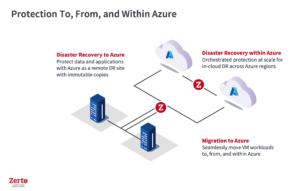
The new version Zerto 10 for Microsoft Azure is ideal for native protection for VMs in Azure. It brings an improved solution for disaster recovery and mobility, also supports multi-volume VMs and offers improved scale-out efficiency for more infrastructure flexibility.
Zerto, a Hewlett Packard Enterprise company, introduces Zerto 10 for Microsoft Azure. The solution provides enhanced disaster recovery (DR) and data mobility capabilities to help organizations protect their Azure workloads from increasingly sophisticated threats. The core of the improvements in Zerto 10 for Microsoft Azure are a new, cloud-based replication architecture in terms of more efficient scale-out infrastructures and native protection for VMs in Azure.
Consistency across multiple disks of VMs

🔎 Zerto 10 offers a new replication architecture for scale-out efficiency and native protection of Azure VMs to, from and within the cloud (Image: Zerto).
The improved solution now includes support for consistency across multiple disks of VMs in Microsoft Azure. This helps organizations protect their data not only in transit to and from the Azure platform, but also across Azure regions within the cloud. To do this, Zerto coordinates replication for all virtual disks associated with a VM in Azure to ensure data consistency for failover and recovery. Zerto 10 offers a new replication architecture for scale-out efficiency and native protection of Azure VMs to, from and within the cloud. The solution also simplifies platform management.
"Zerto 10 for Microsoft Azure offers organizations unparalleled flexibility and scalability for their infrastructure, native protection for Azure VMs, and cross-region support for seamless disaster recovery and mobility," said Matt Boris, vice president of global go-to-market at Zerto. "With improved scale-out efficiencies and cloud-based virtual replication appliances, Zerto keeps businesses protected in the cloud."
More at Zerto.com
About Zerto
Zerto, a Hewlett Packard Enterprise company, provides its customers with the ability to run their business resiliently by simplifying the protection, recovery and mobility of on-premises and cloud applications. The Zerto cloud data management and data protection platform removes the risk and complexity of migrations and cloud environments in private, public and hybrid clouds.
